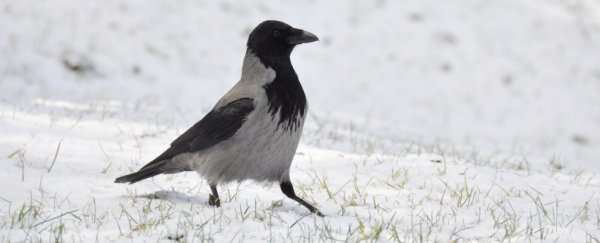Two European crows that look quite different from each other are actually diverging from a single species, right before our eyes. In Western Europe, it's the inky-black carrion crow (Corvus corone). In the east, the grey hooded crow (C. cornix).
They overlap in a very narrow zone running along the River Elbe in Germany, where they sometimes mate with each other to produce fertile hybrids - a strange result, since many species hybrids are infertile.
Now, genomic analysis has revealed that C. corone and C. cornix are actually almost indistinguishable from a genetic standpoint. The only significant genetic difference between them can be found in the gene responsible for colouration.
"Defining speciation as the buildup of reproductive isolation, carrion crows and hooded crows are in the process of speciation," said evolutionary biologist Jochen Wolf of Ludwig-Maximilians-Universität in Munich.
Speciation is the slow process of evolving into a distinct species, and it usually takes quite a while, with many organisms in a constant state of evolution. It can occur a number of different ways. Last year we heard about the first direct observation of hybrid speciation in Galapagos finches, for example.
The speciation of carrion crows and hooded crows is occurring via a different mechanism. Rather than two species coming together to create a new one (like in the case of the finches), the crows started from a single European species, which is in the process of splitting apart.
Scientists believe this process probably began during the Last Glacial Period, from around 115,000 to 11,700 years ago. During this time, there were alternating periods of glacial advance and retreat, which likely forced populations of crows to separate.
When they came back together when the world warmed up again, some of them were… different.
"Most probably, a mutation had arisen in the easterly population, which endowed its carriers with a lighter coloured, grey plumage," Wolf said.
But instead of mixing back up into one population, it was only in that narrow zone around the River Elbe that the two types of crows came together, occasionally mating and producing hybrid crows with a colour somewhere between the carrion crows' shimmering black and the hooded crows' grey.
Exactly what was keeping the two populations apart was unclear - so Wolf and his colleagues performed genetic analyses of around 400 birds. These were selected from within the hybrid zone, as well as the zones on either side, where the species' territories don't overlap.
"Only two major effect genes which together encode the feather colour differ sharply on either side of the hybrid zone - the gray alleles are not found to the west of the zone and the black allele is absent in the eastern region," Wolf said.
"That's a very strong indication that there is rigorous selection on the basis of colour."
This suggests the crows are choosing mates based on colour. Birds of a feather literally, in this instance, flock together - carrion crows prefer black mates and hooded crows prefer grey ones.
Sadly, this puts the poor old hybrids at a selective disadvantage - although they're fertile, they're less likely to find a mate because of their odd colouration.
What the hybrid zone does show is that the speciation of hooded crows and carrion crows is still in its early stages. For "true" speciation, hybrid offspring generally needs to be infertile.
But, because each population tends to mate only with their own kind, gene flow is locally restricted. If they continue that trend, full speciation is likely only a matter of time. And it doesn't look like they're going to integrate any time soon, even within that very small hybrid zone.
"We are now using a mathematical model to work out the level of hybridisation in the hybrid zone as it now stands," Wolf said. "The initial indications suggest that it is very low, on the order of a few percentage points."
The research has been published in Nature Ecology & Evolution.
